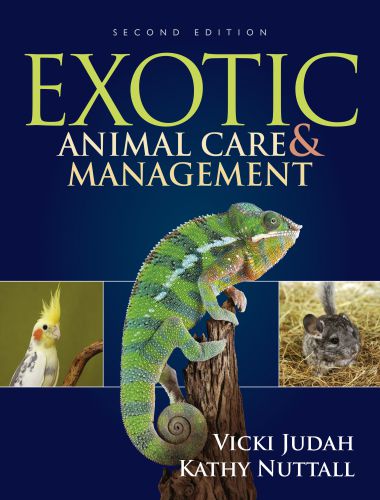Exotic Animal Care and Management 2nd Edition was designed to provide information on the ever-growing, ever-changing field of exotic animal husbandry and seeks to develop the technical skills needed for those students who wish to further their education, pursuing careers as veterinary assistants, veterinary technicians, or veterinary technologists.
Exotic Animal Care and Management 2nd Edition

In this same vein, this new second edition of Exotic Animal Care & Management strives to be as equally informative and timely, providing information to reflect the changing pet population and clearly explaining various techniques required of these professions.
Our human need for companion animals is ingrained and is probably the reason that the first orphaned wolf cub or injured young bird was taken in and cared for by our ancestors. It is a need far different from capturing, killing, and consuming. Over time, our attitudes have changed greatly. Animals are no longer just pets, but have become companions and family members. The dogs, cats, and endless hamsters of childhood have been joined by animals that are more unusual, strange, and exotic. Never before have there been such a variety of species and so little accurate information generally available.
The availability and affordability of many species have outpaced the knowledge needed to care for them. This, in turn, has produced countless experts whose personal experience is delivered as fact and clouds what real information is available. Pet store shelves are filled with glossy books, and racks of care sheets, yet sugar gliders are still hawked in the shopping malls as cute little pocket pets, and nonnative species are being released when they become too large, too aggressive, or too non cuddly.
Download More Book: Exotic Animal Hematology and Cytology 4th Edition
The problem is accelerating and there are serious ethical questions regarding many species currently being sold, bred, and traded with little thought given to their very specific needs and welfare. Many states have banned the sale of certain species. USDA permits are required for possession of many others. Laws have been enacted to address irresponsible ownership, the reality of nonnative species introducing disease, and the rising number of incidences of rarely seen zoonotic diseases.
Exotic animals are presented to veterinary staff usually when a major health issue becomes apparent or the home remedy or pet store treatment has failed. Then, an owner expects an immediate cure, whether for an iguana in renal failure (“but he loves cat food”), an aggressive chinchilla that is actually a wood rat (delivered to the exotic vet from another small-animal clinic), or the Ball Python presented with an esophageal laceration due to an inept attempt to force feed a tofu sausage concoction (“because eating rats is mean”).
| PDF Size: 28 MB | Book Download Free |
Password: pdflibrary.net
